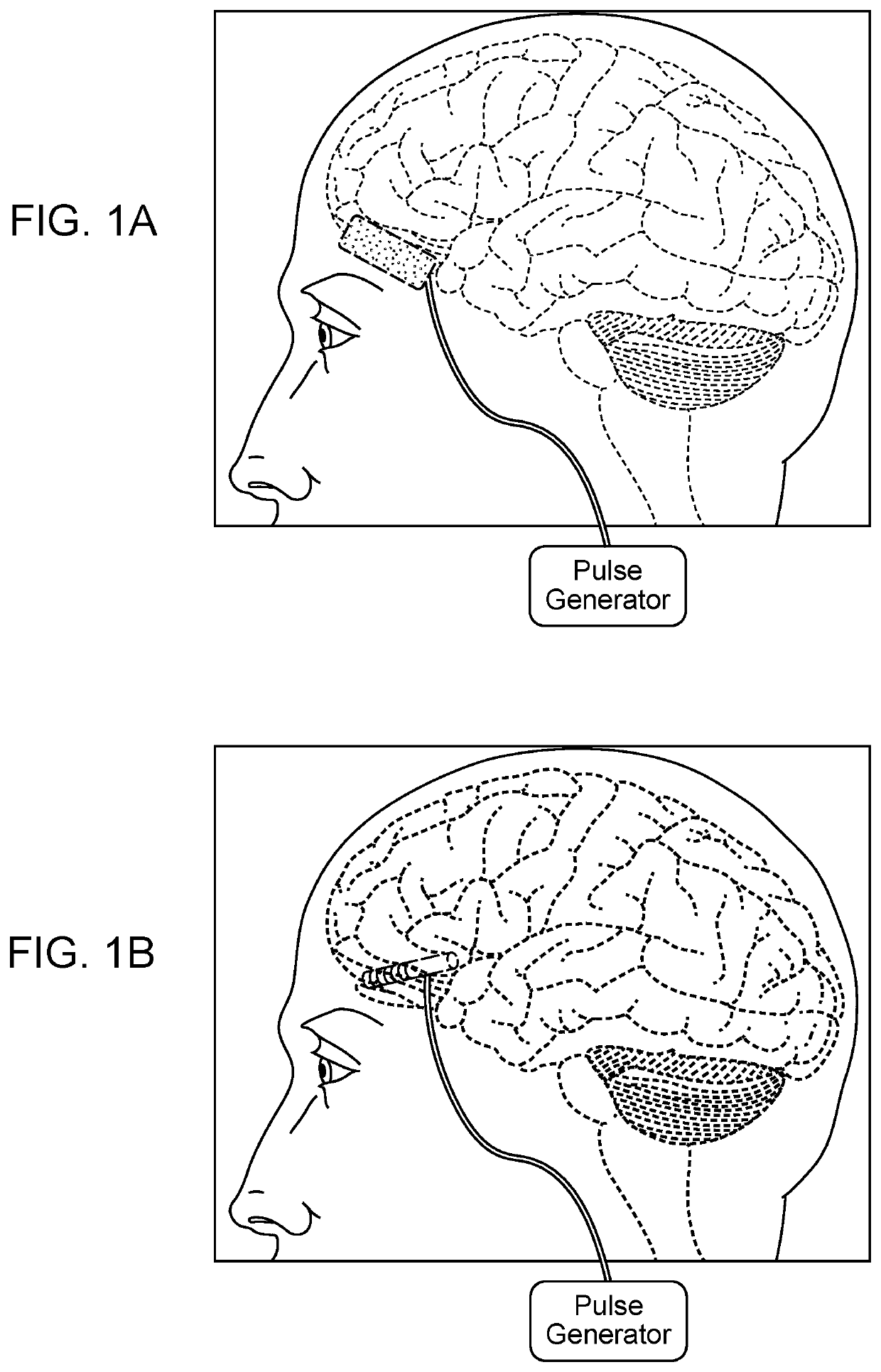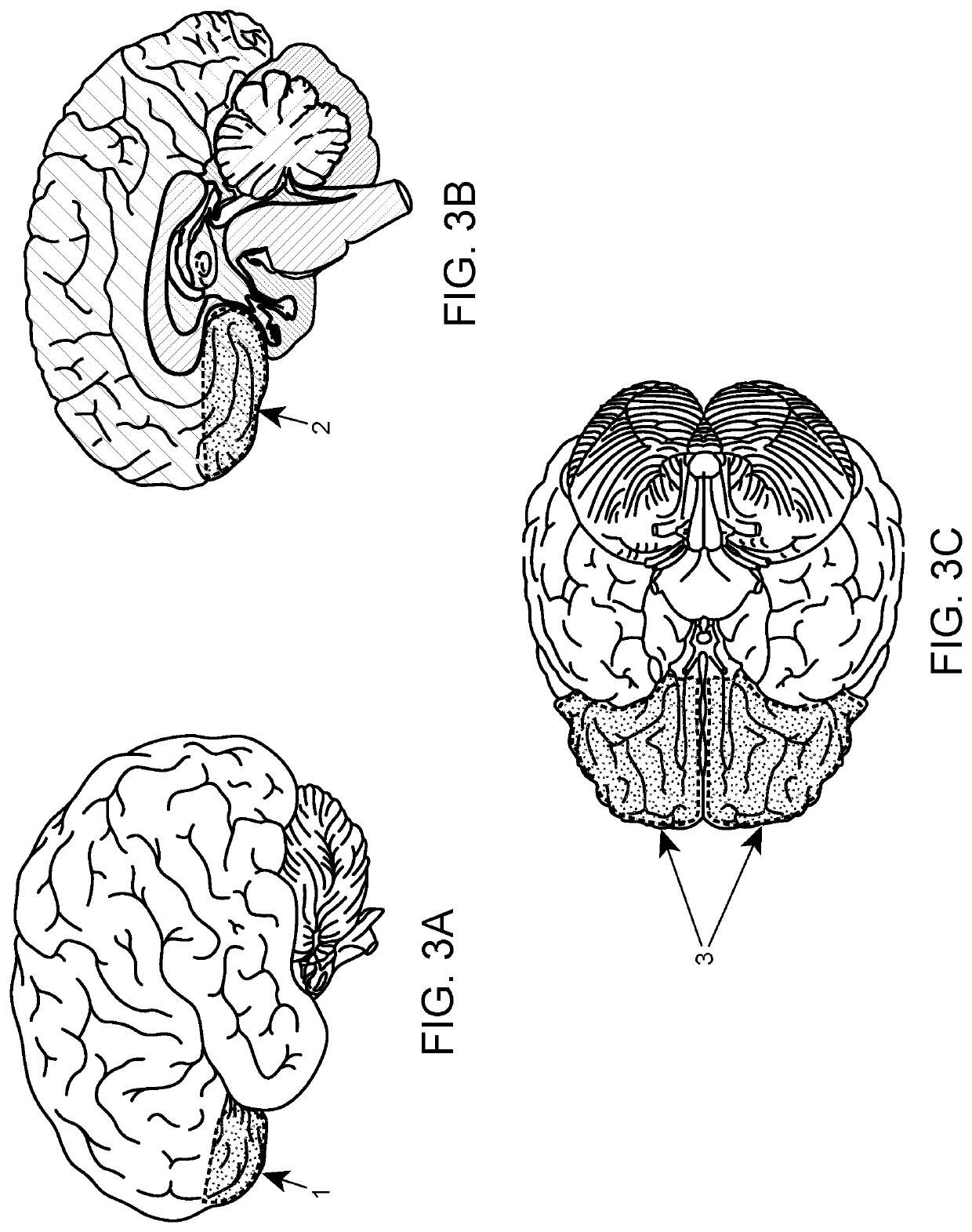Method of neural Intervention for the Treatment of Affective Neuropsychiatric Disorders
a neuropsychiatric disorder and neural intervention technology, applied in the field of neural intervention for the treatment of affective neuropsychiatric disorders, can solve the problems of high invasiveness of surgical lesioning approaches for neuropsychiatric disorders, ineffective treatment of large numbers of patients, and inability to achieve optimal outcomes, so as to improve anxiety, reduce bai score, and improve chronic pain-related distress
- Summary
- Abstract
- Description
- Claims
- Application Information
AI Technical Summary
Benefits of technology
Problems solved by technology
Method used
Image
Examples
example 1
for Electrical Stimulation of OFC Region of Brain
[0159]FIG. 1 shows lateral views of the brain surface with a surface electrode array (FIG. 1A) or a depth electrode array (FIG. 1B) placed within the OFC region. The electrodes may apply electrical stimulation to a site or sites within the OFC region and its immediate surroundings. The parameter of the stimulation is set to effect changes in physiological activity in neural networks related to the etiology or symptomatology of neuropsychiatric disorders. Under this method, the electrical stimulation is provided by a pulse generator connected via implantable leads to an electrode or electrodes in contact with the brain. Schematic depictions of such pulse generator / lead / electrode arrangements are shown in FIGS. 2A and 2B. Schematic depictions of the OFC region are shown in FIGS. 3A, 3B, and 3C and in FIGS. 4A and 4B. Schematic depictions of generator / lead / electrode / controller arrangements capable of delivering programmed stimulation to ...
example 2
se System for Therapeutic Application of OFC Stimulation
[0160]Examples of therapeutic application of OFC stimulation are described below. These and related applications may be utilized in the context of a clinical system for the treatment of neuropsychiatric disorders. FIG. 7 shows the steps performed in this system. In the first step, a patient is evaluated for need for OFC stimulation-based treatment, on the basis of a number of assessments including clinical neuropsychiatric assessments, cognitive assessments, measures of anatomical, biophysical, and / or functional brain features and / or connectivity, and other related evaluations. In the second step, patients selected for treatment are evaluated for electrode placement on the basis of the preceding assessments and related measures. In the third step, patients undergo electrode and / or electrode-integrated stimulation device implantation. This step may include a tailored electrode configuration for OFC recordings (tailored array sha...
example 3
Stimulation for Symptom Relief
[0161]In the example shown in FIG. 1A, stimulation is delivered to at least one electrode (aka contact) located on the surface of the OFC, with electrodes configured individually or as part of a strip or surface array (as shown); in the example in FIG. 1B, stimulation is delivered to at least one electrode located within the OFC and under the cortical surface, with electrode or electrodes configured as part of a depth electrode array. In both the surface-electrode and depth-electrode configurations, stimulation is delivered from the pulse generator, continuously, periodically or intermittently, with the purpose of alleviating or preventing further neurophysiological disease symptoms. In this example, stimulation is performed in an “open loop,” under a regimen or set of parameters that is not automatically modified by the neurophysiological brain state.
[0162]In this example, as depicted in FIG. 8, stimulation may be delivered to provide acute alleviation...
PUM
 Login to View More
Login to View More Abstract
Description
Claims
Application Information
 Login to View More
Login to View More - R&D
- Intellectual Property
- Life Sciences
- Materials
- Tech Scout
- Unparalleled Data Quality
- Higher Quality Content
- 60% Fewer Hallucinations
Browse by: Latest US Patents, China's latest patents, Technical Efficacy Thesaurus, Application Domain, Technology Topic, Popular Technical Reports.
© 2025 PatSnap. All rights reserved.Legal|Privacy policy|Modern Slavery Act Transparency Statement|Sitemap|About US| Contact US: help@patsnap.com



